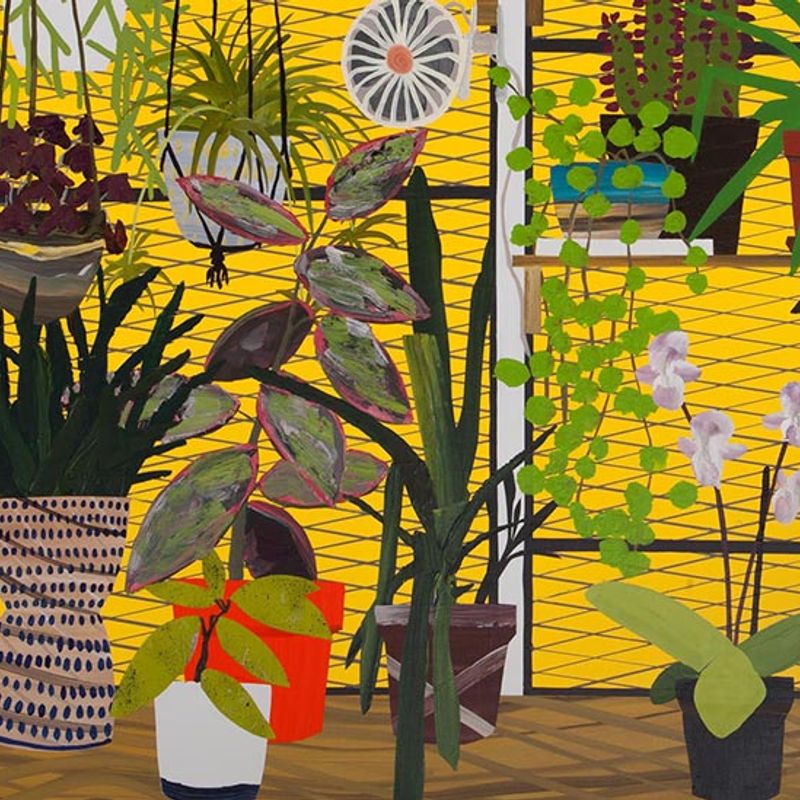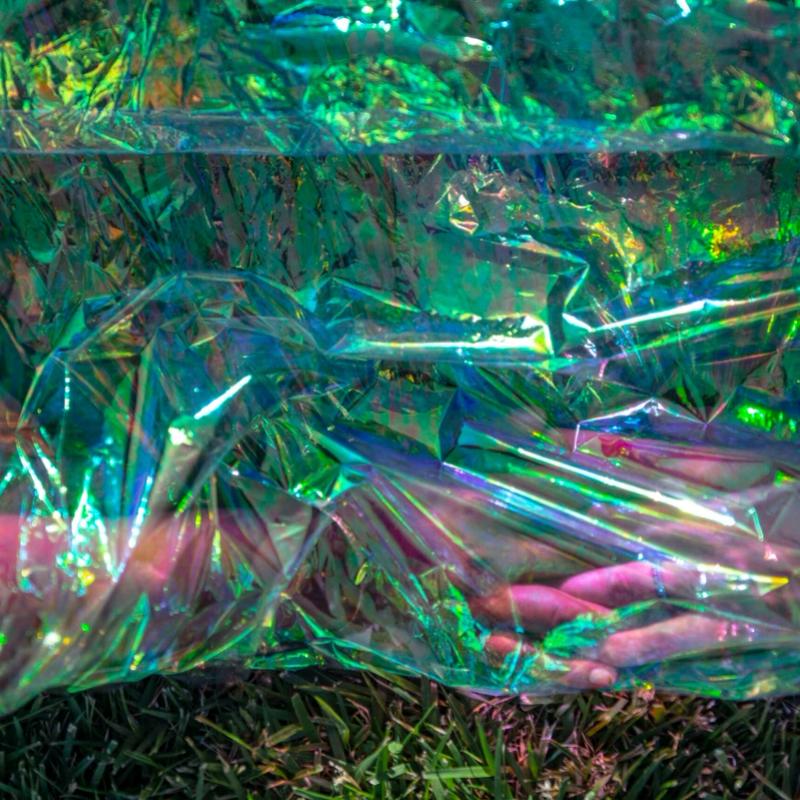In Conversation: A Poet Asks a Sculptor
by Sarah AudsleyPoet Sarah Audsley asks artist Kristy Hughes some questions for Shenandoah’s Spring 2024 Issue.
As a longtime fan of yours, it was an extra-special pleasure to see your work in person for the first time in the two-person exhibition Speak Nearby at the Colburn Gallery at the University of Vermont. I really enjoyed standing in front of and interacting with your large portals, looking through them and thinking about what it means to take up space. As a poet, in my current practice, I haven’t yet tried to write a long poem, which I equate with taking up space on the page. What does taking up space, in your sculptural practice, with your portals and other pieces, mean to you?
Thanks for seeing the show!! And I’m such a fan of your work as well. I’m excited to talk with you in this capacity. It’s such a pleasure.
I started making sculptures right before the pandemic, specifically to “take up space.” Before this, I was working on collaged paintings. At that time in my life, I felt small, voiceless, and unseen. I turned to my work to figure out how to have agency, at least how to amplify this notion through material means. By making work that physically takes up space, that is unapologetically vibrant, piecemealed, sometimes funny, and ultimately joyful, it helped me to personally reclaim agency and uncover my own voice. Making sculptures continually teaches me how to be empowered, to be sure.
More recently, over the last several months, I’ve started to consider what “taking up space” can look like, even when the work is small. How through slowing down to notice, experiencing new ways of paying attention, and getting closer to something can also create a seismic shift. Maybe this shift is an internal “taking up space” rather than a physical one.

Portals, Acrylic, Fiberglass, Polymer, Joint Compound, PVA Glue, Gifted Rock from Coast Guard Beach, Truro, MA, 93”x47”x12”, 2023. Courtesy of the artist.
As an extension to the first question, thinking about scale: Was there a point where you wanted to work at a larger scale? How do you know when to make the move to scale larger? Or when to stay at a smaller size? What dictates that decision-making process?
When I have a large studio, the concept always dictates the size. “Portals” that you mentioned earlier, is 93” tall, and was specifically made to tower over the viewer, demanding their physical shift in perspective as they navigate around it, or through it. But recently my studio size has been the biggest factor in my decision making regarding scale. I’m currently in a very small office space turned studio. I am surrounded by therapist offices, above a Subway restaurant, and down the hall from State Farm Insurance. I can’t be that loud, can’t make something too big, and definitely can’t work with toxic materials. So, I’ve shifted to smaller sculptures and wall pieces. I am really interested in how surroundings always have a play in the outcome. I try to view the challenges that each studio space may have as opportunities to shift my work or approach it in a different way. Scale has definitely been one of the biggest factors recently.

Casita, Acrylic, Monotype, Collage, Fiberglass, Polymer, Plaster, PVA Glue, Cardboard, 75”x70”x22”, 2023. Courtesy of the artist.
Of course, color and color palette are essential tools for the artist, so I’m interested in your bold primary color choices, stripes, and varied patterns. Josef Albers’s Interaction of Color is a seminal text on the subject. How do you respond to his legacy as the “color expert”? Do you use his studies as a reference or as a point of departure? Or something to push against or be in conversation with?
I teach Albers in my painting and color theory classes. I believe it’s brilliant to study color as material itself. It’s relative, and changes according to whatever it is next to. It blows my mind every time I do a simultaneous contrast study, or middle mixtures especially. Outside of teaching, I don’t predetermine color necessarily, or use his studies in my own work.
I use color and pattern as ways to elevate small but very special moments, or to bring levity to a piece. While painting for me is broadly intuitive, my color palettes do come from moments I’ve noticed within my surroundings. I’m constantly stopping to take photos of color combinations that I find compelling in the world. Most patterns are based on specific references that I personally love, that I find bonkers, or just funny—rocks, bugs, RV’s, and 80s and 90s clothes are a few examples. I just visited New Mexico, my childhood home, and the light pinks, deep red oxides, tans, soft light orange, and endless sky blue are singing in my mind. They’ve already started to influence my newest works.
Fiberglass, as a medium, seems intimidating to tackle. What drew you to working in this medium?
I came to sculpture as a printmaker and painter, having never taken a sculpture class. How to make a thing stand? I started working with insulation foam because it was the material that made the most sense for me to build with. It’s light, I can build with it intuitively, can cut it easily, and it works kind of like a puzzle, or like collage. I cut out shapes and piece them together, using glue and screws. Insulation foam isn’t very strong itself, hence the need for fiberglass. I watched a lot of boat-making videos. I talked to sculptor friends and did a lot of experiments. At the time, I also had an outdoor space to work and a studio with great ventilation.
Fiberglass works great, especially over the insulation foam and over cardboard. Using it for the last three years has allowed me to really understand how to make sculpture. But, now in my smaller space, I’ve recently started using paper pulp instead, and am so excited about it! For strength, I add joint compound and glue to the pulp. I’ll stick with the paper pulp for now, and will return to fiberglass once I get the opportunity to make an outdoor sculpture.


Home is Between Your Teeth, Acrylic, Cast Paper, Handmade Paper Pulp, Papier-mâché, Joint Compound, PVA Glue, Collected Wood from Rock Point, Burlington, VT, 19.5”x14.5”x12”, 2024. Courtesy of the artist.
A common quoted phrase from Robert Frost is “No tears in the writer, no tears in the reader. No surprise in the writer, no surprise in the reader.” How does (or doesn’t) this phrase resonate for you as a sculptor and maker?
Yay for this question, because my MFA thesis show back in 2014 was based on a Robert Frost poem, “For Once, Then, Something.” It’s about how perspectives shift the longer you pay attention. The more you look, the more you see. It was such an important poem for me at that time.
To address the question though, I cannot make something that doesn’t interest me, that doesn’t surprise me, that I don’t yearn to find the answer for. I get bored very easily, and my attention jumps around, so I have to be zoned into something to be able to work on it for months. I typically make to figure something out, chasing a curiosity, to be shocked at color interactions, to be in awe of a sculptures’ perfectly awkward form, to shriek with joy when something just fits, and cry when I figure something out about myself through the act of making. Making is all or nothing. In making, I’m chasing, searching. The search is enough.

Acoustic Mirror, Acrylic, Cast Paper, Handmade Paper Pulp, Papier-mâché, Joint Compound, Polymer, Collected Rocks from Provincetown, MA, 22.5”x18”x17”, 2024. Courtesy of the artist.
What does ambition mean for you regarding your art?
Ohh. I sigh aloud, as I have five tabs open for different grant and residency applications I’m currently applying for. But I apply to these so I can continue making the work I need to make—for my work to be in conversation with other work, for myself as an artist to build my community of other artists, writers, thinkers, and makers, to grow and push myself and my practice. Ambition for me is just a guise for doing what I need to, to keep making. I hope I’ll be lucky enough to find ways to make work my entire life. And, I hope to have the means, opportunities, spaces, time, and community in which to make it, the best that I can.

Detail of Shape of a Rock (Heart), Acrylic, Colored Pencil, Fiberglass, Steel, Polymer, Plaster, PVA Glue, Collected Rocks from Herring Cove Beach and Provincetown Harbor, MA, 75.5”x18.5”x10”, 2023. Courtesy of the artist.
What keeps you motivated to return to the studio and your practice?
Once I found art, it became a lifeline. This happened for me in college. First it was in the print shop, then through collaging and painting, and now sculpture. Art has unequivocally changed my life. While it’s of course in the making, it’s also equally in the community that surrounds it. Art connects you with people. It’s brought me my deepest friendships. I met my husband in the Indiana University printmaking shop, graining a litho stone. Art is so much more than what you do in your studio, it’s in the people that surround you, in the sharing, the reading, in talking about work, in shaping a life that centers around it all. Of course the studio also holds frustration, mundane tasks, and a thousand failures before any success, but ultimately for me, making my work is freedom.
I have this pinned to my studio wall, something I wrote down a few years ago that still rings true, ”When your work talks to you, and then you realize you made the work, so in fact you are talking to yourself. But you weren’t able to articulate the truth, not without the work.” This happens to me over and over, and I think I keep coming back to my studio because I need to know more.

Shape of a Rock (Heart), Acrylic, Colored Pencil, Fiberglass, Steel, Polymer, Plaster, PVA Glue, Collected Rocks from Herring Cove Beach and Provincetown Harbor, MA, 75.5”x18.5”x10”, 2023. Courtesy of the artist.


